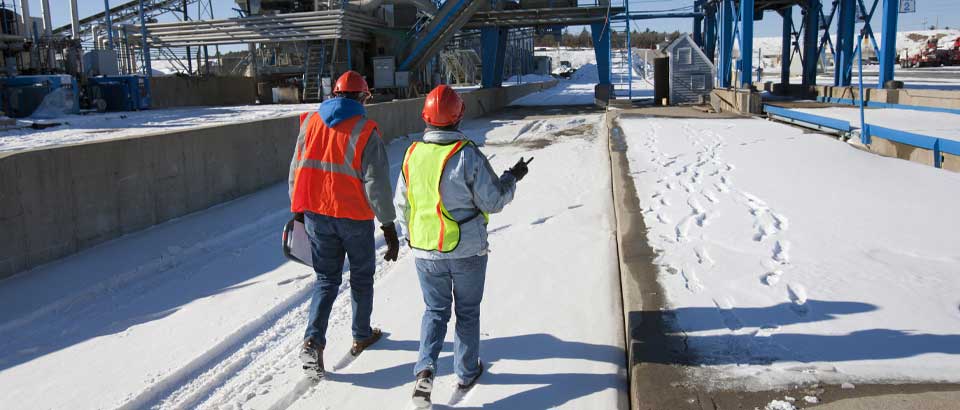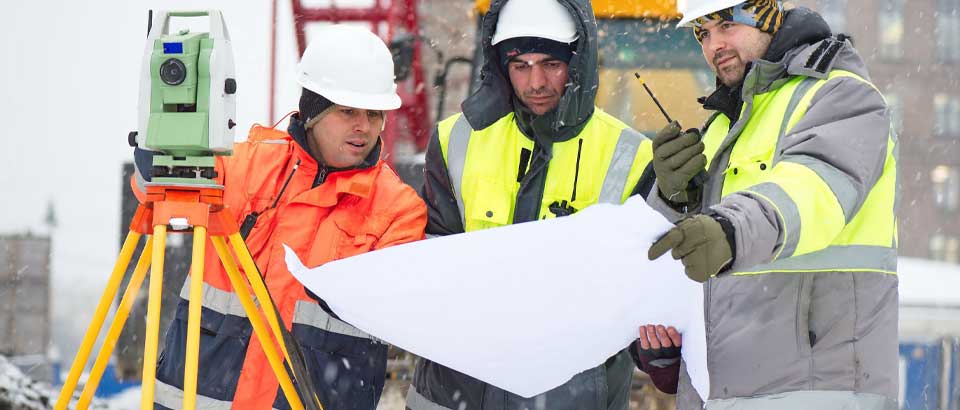November 21, 2022
Every day, almost half of civilian American workers work outside at some point in the workday. That doesn’t include non-civilian workers, such as law enforcement officers, mail carriers and firefighters, who may be outside over 90% of the time they are on duty.1 Working outside when temperatures drop and frigid weather moves in puts workers at risk for cold stress, which can lead to serious and even life-threatening health conditions. Even working indoors in extremely cold conditions such as freezers can also bring on cold stress.2

What is Cold Stress?
Cold stress is an umbrella term for conditions where skin and body temperature go down to potentially dangerous levels. If a person’s body can’t warm itself, illnesses and injuries related to cold weather, such as frostbite, chilblains, hypothermia and trench foot, can happen. Some of these conditions can lead to permanent tissue damage and even death.3 Medical studies have shown that cold stress has a negative effect on health, performance and tolerance.4,5
It’s important to protect your workforce from the health issues that can happen from cold stress. Learning what signs to watch for and how to best handle cold weather work conditions keeps your employees safe and your business thriving.
Frostbite
Frostbite6 is a bodily injury caused by exposure to freezing temperatures. Most of the time, it affects the nose, fingers and toes, ears and cheeks. Frostbite can cause permanent tissue damage and lead to amputation. Signs to watch for include:
- Numbness or tingling
- Stinging or aching
- Pale, bluish or waxy skin
- Red or gray patches of skin
Hypothermia
Hypothermia6 is abnormally low body temperature due to prolonged exposure to cold temperatures. The body will use up stored energy in response. Low body temperature can lead to confusion and difficulty in moving. A person suffering from hypothermia can be so disoriented they don’t know they are in danger. Signs to watch for are:
- Shivering
- Fatigue
- Lack or loss of body coordination
- Confusion
Chilblains
Chilblains result from skin being repeatedly exposed to temperatures ranging from just above freezing to 60 degrees Fahrenheit. The exposure causes permanent damage to small blood vessels in the skin. Chilblains most often affect the fingers, toes, cheeks and ears. Signs to watch for include:
- Redness, itching and/or inflammation of the affected area(s)
- Blisters
- Skin ulceration (in severe cases)
Trench Foot
Also known as immersion foot, this condition comes from the feet being exposed to cold, wet conditions. It can happen in extreme cold or in temperatures up to 60 degrees Fahrenheit if the exposure is constant. Wet feet lose body heat 25 times faster than dry feet. Blood vessels constrict in response, which causes loss of circulation and a lack of oxygen to the skin of the feet. This may lead to permanent skin loss and damage. Signs to watch for include:
- Numbness
- Leg cramps and/or tingling pain
- Skin changing color to red, dark purple, gray or blue*
- Blisters, ulcers or bleeding under the skin
- Swelling and/or inflammation
*Skin that is dark purple, gray, or blue may indicate gangrene. Seek medical help immediately.

How to Keep Workers Safe from Cold Stress
It’s important to have a plan to protect employees from cold stress. Here are some tips so you can create a plan for your company and employees.7,8,9
Appropriate Clothing:Consider the fabric content of clothing. Cotton loses its insulation properties quickly, while fabrics like wool, silk and synthetics offer better and longer-lasting insulation. Layering appropriate clothing is another important consideration. OHSA recommends cold weather layers as follows:
- First layer (against skin): wool, silk or synthetic to keep moisture away from skin.
- Second layer: wool, silk or synthetic to provide additional insulation even if it gets wet.
- Third layer (outer): clothing that protects against cold, wind and rain while also providing appropriate ventilation.
Employees working in cold temperatures should have a hat or hood that covers the ears to both prevent body heat from escaping through the head and to protect the ears, which are especially sensitive to damage from the cold. Additionally, workers need insulated and preferably water-resistant gloves to protect hands and fingers, and boots or other footwear that are both insulated and water-resistant or water-repellant. If necessary, a knit mask can also be worn to provide additional face protection.
Hydration: While most people associate dehydration with heat, it is also easy to become dehydrated in cold temperatures. Employees should have access to plenty of liquids. Warm sweetened liquids are recommended such as hot tea or hot cocoa.
Education: Ensure that workers and supervisors know the signs and symptoms of cold stress. They should always monitor their physical condition as well as that of their coworkers.
MedExpress Pro Tip: Educate your employees about what they can do to help someone who may be suffering from a cold stress illness or injury to help prevent further damage. Here are the basic steps:
- Contact a supervisor and request medical assistance immediately.
- Move the injured person into a warm room.
- Remove all wet clothing, shoes and equipment and get the person dry.
- Try to increase body temperature with blankets and warm drinks (no alcohol).
If the person is unconscious, isn’t breathing, has slow or no pulse, or appears to be in any other imminent danger, call 911 or go to the nearest emergency room immediately
Use the Buddy System: Workers should not work alone in cold temperatures. Have employees work in pairs or groups so they can monitor each other.
Smart Scheduling: Schedule heavy work for the warmest part of the day. Have employees take frequent breaks in a warm room. Example schedules for both light and heavy work that include breaks and temperature considerations can be found on the OSHA Cold Stress site.
Remember to consider wind chill when scheduling. Wind chill can make temperatures feel much colder. The National Weather Service offers a wind chill chart and calculator to make this easier.10
interested in learning more?
If cold stress causes injury or illness that is not life-threatening, our team is here to help from 8 to 8, every day. Your employees can get the care they need on their schedule and get back to feeling better fast with our urgent care and workers’ compensation services.
References:
1 U.S. Bureau of Labor Statistics: Over 90 percent of protective service and construction and extraction jobs require work outdoors. Accessed October 14, 2022.
2 OHSA Quick Card: Protecting Workers from Cold Stress. Accessed October 14, 2022.
3 University of Iowa Environment Health and Safety: Cold Stress. Accessed October 14, 2022.
4 Comprehensive Physiology: Cold Stress Effects on Exposure Tolerance and Exercise Performance. December 2015.
5 Frontiers in Bioscience: Cold thermoregulatory responses following exertional fatigue. Accessed October 14, 2022.
6 Centers for Disease Control and Prevention. Cold Stress: Cold Stress – Cold-Related Illnesses. Accessed October 14, 2022.
7 University of Iowa Environmental Health & Safety: Cold Stress. Accessed October 14, 2022.
8 OHSA. Cold Stress Guide: Accessed October 14, 2022.
9 OSHA: Cold Stress: Accessed October 13, 2022.
10 National Weather Service: Wind Chill Chart. Accessed October 14, 2022
11 Centers for Disease Control and Prevention: Cold Stress. Accessed October 13, 2022.
12 OHSA Quick Card: Protecting Workers from Cold Stress. Accessed October 14, 2022.
